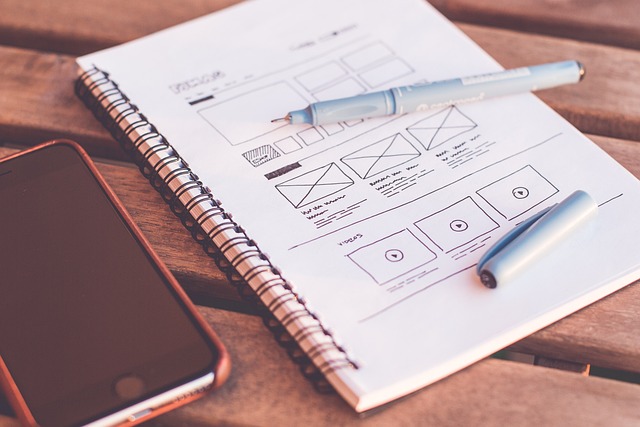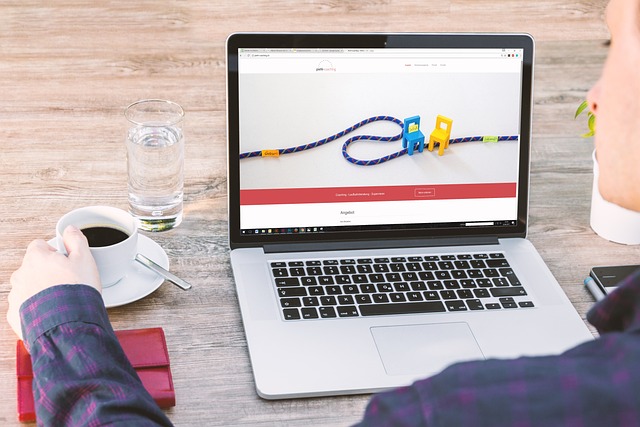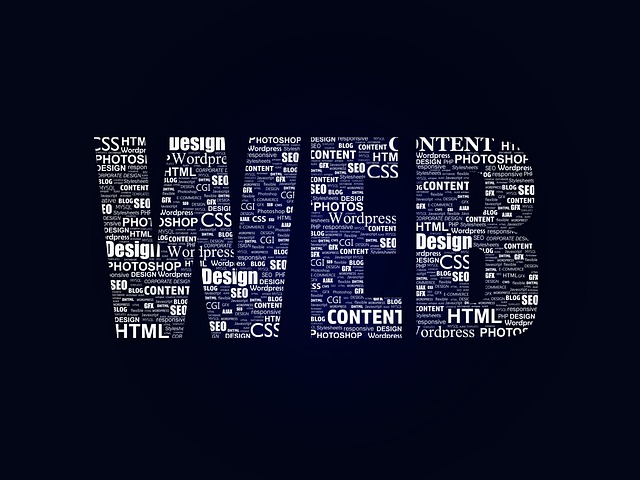The latest web design trends prioritize responsive design, minimalism, clean layouts, and interactive elements to enhance user experiences across all devices. These trends focus on accessibility, fast loading times, strategic typography, color psychology, and dynamic animations. By leveraging these practices, designers create inclusive, visually appealing, and high-performing websites that engage users and boost online brand presence, keeping pace with the ever-evolving digital landscape.
In the ever-evolving digital landscape, understanding the latest web design trends is paramount. Web design best practices not only enhance user experiences but also drive engagement and brand loyalty. From responsive designs adapting to diverse screens to minimalistic layouts simplifying navigation, each element plays a crucial role in creating effective online presences. This article explores these trends and provides insights into visual hierarchy, typography, color psychology, interactivity, accessibility, speed optimization, and mobile-first approaches, guiding you through the evolution of web design.
Understanding the Evolution of Web Design: Unveiling the Latest Trends

The evolution of web design is a dynamic process, constantly reflecting and shaping our digital landscape. To grasp the current state and predict future trends, it’s essential to explore the latest web design practices that have emerged from this evolution. Today’s web design goes beyond simple aesthetics; it involves creating intuitive user experiences, leveraging responsive technologies, and prioritizing accessibility for diverse audiences.
The latest web design trends showcase a focus on minimalism, clean layouts, and effective use of negative space, ensuring content remains the focal point. Interactive elements, animations, and micro-interactions enhance user engagement, while micro-optimizations improve page load speeds. Additionally, the integration of AI and machine learning algorithms personalizes experiences, catering to individual user preferences and behaviors. These trends not only elevate the visual appeal but also drive better conversion rates and foster stronger user connections.
Responsive Design: Adapting to Diverse Screens and Devices

In today’s digital era, the latest web design trends place a strong emphasis on responsive design to cater to diverse user needs and screen sizes. This approach ensures that websites seamlessly adapt and display optimally across various devices, from desktops and tablets to mobile phones. Responsive design is no longer an option but a necessity, as users expect seamless experiences regardless of their technology. By utilizing flexible layouts, fluid images, and media queries, web designers can create dynamic and accessible sites that offer the same rich content and functionality on all platforms.
This adaptability extends beyond common desktop and smartphone screens, considering emerging technologies like smartwatches and voice-activated devices. A well-executed responsive design strategy involves testing and refining the user interface for various screen resolutions, ensuring legibility, touch accessibility, and fast loading times. By embracing these latest web design trends, developers not only meet but exceed user expectations, fostering a positive perception of brands and enhancing overall digital experiences.
Minimalism and Clean Layouts: Simplifying User Experiences

In the realm of web design, minimalism and clean layouts are emerging as key elements in enhancing user experiences, aligning with the latest web design trends. By stripping down designs to their essential components, designers create visually appealing and intuitive interfaces that prioritize content and functionality. This approach not only improves load times but also fosters better usability, enabling users to navigate websites efficiently.
Minimalist aesthetics, characterized by simple lines, ample white space, and a limited color palette, reduce cognitive load and help users focus on the primary goals of a webpage. Clean layouts, on the other hand, ensure that content is organized logically, making it easier for visitors to find what they’re looking for. This simplicity also encourages better search engine optimization (SEO), as clean code and well-structured pages are favored by algorithms.
Visual Hierarchy and Typography: Guiding Users Through Content

In the realm of modern web design, visual hierarchy and typography play a pivotal role in guiding users through content effectively. The latest web design trends prioritize clear and strategic layout structures to ensure visitors can easily navigate and comprehend information. By organizing elements with varying sizes, colors, and placement, designers create a natural flow that draws the user’s eye to essential content first. This practice is crucial for capturing attention and encouraging engagement.
Typography, as an integral part of visual hierarchy, adds another layer of guidance. Choosing the right fonts, adjusting spacing, and employing appropriate text weights help convey importance and enhance readability. The latest trends in typography focus on readability and accessibility, ensuring that text is not only visually appealing but also easily digestible for all users, regardless of device or screen size. This attention to detail contributes significantly to creating a user-friendly and enjoyable web experience.
Color Psychology and Branding: Evoking Emotions Through Design

In the realm of web design, color plays a pivotal role in shaping user experiences and brand identities. Color psychology is a powerful tool that allows designers to evoke specific emotions and create meaningful connections with audiences. By understanding the psychological impact of different hues, designers can strategically choose colors that align with their desired branding and latest web design trends. For instance, warm tones like red and orange stimulate energy and excitement, making them ideal for promoting sales or capturing attention. On the other hand, cool colors such as blue and green evoke feelings of calmness and trust, often used in healthcare or financial websites to instill security.
Branding is another key aspect influenced by color choice. Consistent use of brand colors across a website reinforces recognition and builds a unique visual identity. Incorporating these colors in various design elements, from backgrounds and typography to icons and buttons, helps establish a cohesive look that resonates with the target audience. In line with the latest web design trends, minimalism and flat design often highlight clean color palettes, ensuring that brands remain memorable without overwhelming users with excessive or distracting visual stimuli.
Interactive Elements: Enhancing Engagement and Usability

In the realm of modern web design, interactive elements play a pivotal role in enhancing user engagement and overall usability. The latest web design trends emphasize creating dynamic websites that captivate visitors and encourage active participation. By incorporating interactive features like hover effects, animated transitions, and responsive forms, designers can transform static pages into immersive experiences. These elements not only add aesthetic appeal but also serve as vital guides for users, making navigation intuitive and efficient.
Moreover, interactivity facilitates a deeper level of user involvement, fostering a sense of connection with the content. Whether it’s a simple button hover animation or a complex interactive quiz, these elements prompt visitors to explore further, ultimately leading to improved engagement metrics. Web designers should stay abreast of emerging trends in this domain, ensuring their creations remain competitive and appealing in the ever-evolving digital landscape.
Accessibility Considerations: Designing for All Users

In today’s digital landscape, ensuring your website is accessible to all users is not just a moral imperative but also a key aspect of the latest web design trends. Accessibility considerations encompass making your site usable by people with a wide range of abilities and disabilities. This includes implementing features like alt text for images, proper heading structures, and keyboard navigation to support visually impaired users. Additionally, providing sufficient color contrast, clear content hierarchy, and simple language ensures that users with cognitive or learning disabilities can navigate and understand your website effectively.
By embracing these accessibility practices, web designers not only create more inclusive digital spaces but also benefit from improved search engine rankings, broader audience reach, and enhanced user experience for everyone. Keeping up with these latest web design trends is crucial in ensuring your online presence caters to a diverse range of users, fostering inclusivity and engagement.
Optimizing for Speed and Performance: Ensuring Seamless Browsing

In today’s digital era, users expect websites to load instantly—a seamless browsing experience is non-negotiable. Optimizing for speed and performance is a key aspect of the latest web design trends, ensuring your site doesn’t just look good but functions flawlessly across all devices. Techniques such as minimizing HTTP requests, compressing images, leveraging browser caching, and optimizing code can significantly reduce load times.
These practices not only enhance user satisfaction but also positively impact search engine rankings. Google, for instance, favors fast-loading sites in its algorithms, making speed a critical factor in driving organic traffic. By keeping your website lean, efficient, and quick to respond, you’re creating an inviting environment for visitors, encouraging them to explore more of your content and interact with your brand.
Mobile-First Approach: Prioritizing Mobile Users and Experiences

In today’s digital landscape, where users access websites from a multitude of devices, adopting a mobile-first approach is no longer an option but an imperative. This strategy involves designing web interfaces with a primary focus on mobile users and their unique interactions. By prioritizing mobile experiences, web designers can create seamless and accessible sites that cater to the growing number of smartphone and tablet users worldwide. A mobile-first mindset ensures that the latest web design trends are inclusive, visually appealing, and optimized for faster loading times, ensuring a positive user experience regardless of device size or screen resolution.
This approach demands a shift in traditional design practices, encouraging designers to build responsive layouts, utilize touch-friendly gestures, and simplify navigation for smaller screens. By doing so, web designers can deliver content effectively, allowing mobile users to engage with websites quickly and efficiently. Embracing this trend not only enhances accessibility but also keeps your online presence competitive within the ever-evolving digital space.
